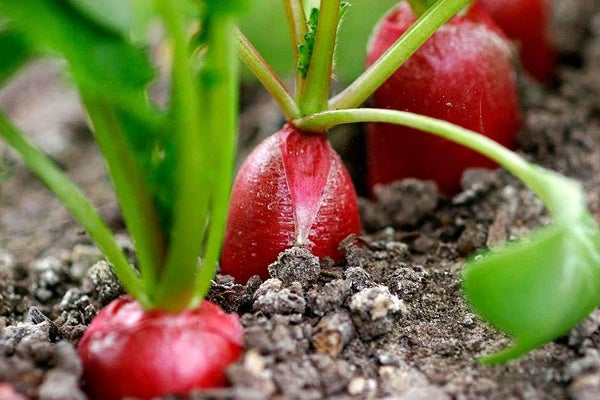
Getting Started
Salad radishes are quick and easy to grow from seed, and are ready to eat in as little as four weeks. These compact plants can be grown in even the smallest of spaces and are great gap-fillers on the veg plot. Sow small batches every few weeks to add a crunchy kick to salads in late spring and summer. There are also winter cropping, oriental and edible-podded varieties.
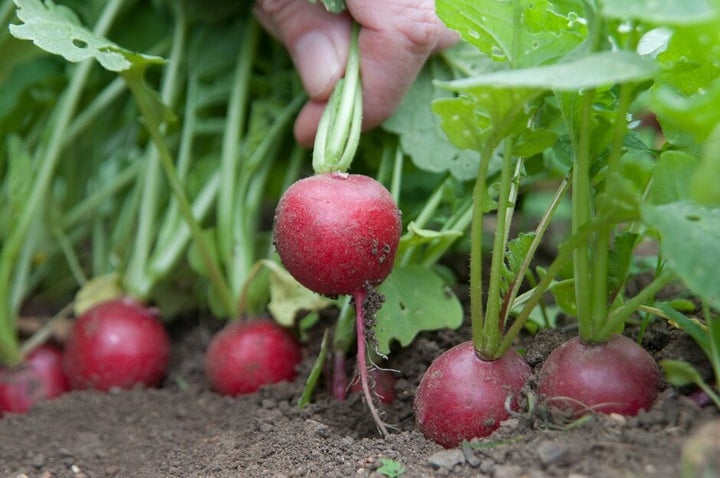
Radishes (Raphanus sativus) belong to the brassica (cabbage) family and are a cool-season crop, growing best in spring and late summer. They form rounded or long roots that are succulent and crunchy, with various levels of pepperiness.
Jobs to do now
Harvest winter radishes
Month by Month
Sow
Harvest
Choosing What To Grow
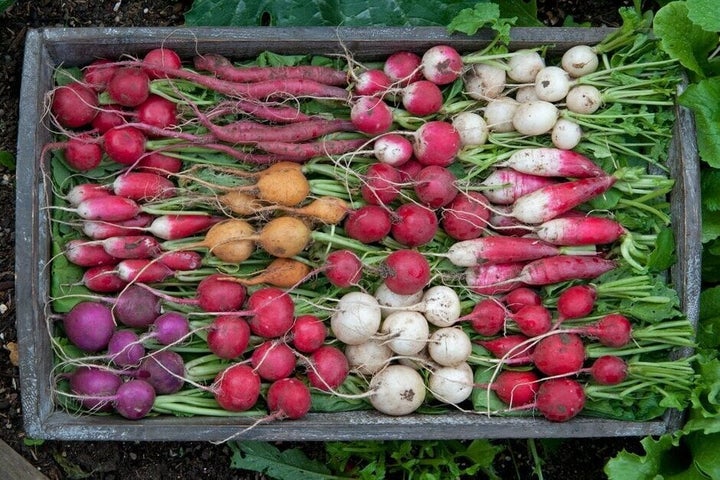
Radishes come in an array of root shapes, sizes and colours, depending on the variety. They range from small globes to long, tapering roots, in shades of red, pink, white, yellow and even black. There are four distinct types of radish to choose from:
- Salad radishes (also known as spring or summer radishes) – these are the most popular and widely grown type. They are small and fast growing, sown in the ground or in containers in spring and summer. There are many varieties, forming small succulent roots in a choice of shapes and colours. Great for eating raw, they are refreshing and crunchy with a peppery kick.
- Winter radishes – these hardy radishes are larger and slower growing, sown in late summer for harvesting in winter. If sown too early, they will bolt (start flowering) and the root won’t swell. Most varieties have a mild flavour, although some can be hot, so check the packet before buying. Winter radishes are mainly used in stews and stir-fries, in a similar way to turnips. The leaves grow up to 45cm (18in) tall and are edible too.
- Oriental radishes (also known as Japanese, daikon or mooli radishes) – they usually form a long white tapering root that can be eaten raw or cooked. They are slow growing, often forming a very long root, and are usually harvested in late summer and autumn.
- Edible-podded radishes – these varieties are grown for their long spicy seed pods rather than their root. They’re very easy to grow and crop prolifically, especially in hot weather. The sprawling flowering stems can reach 45cm (18in) tall or more, producing edible pods for several weeks. They add a peppery crunch to salads and stir-fries.
When choosing radish varieties, look in particular for those with an RHS Award of Garden Merit (AGM), which shows they performed well in trials – see our list of AGM fruit and veg (135kB pdf) and our Recommended Varieties below. For more veg-growing inspiration, visit the RHS gardens, which all grow a wide range of vegetables, including radishes, salads and other quick and easy crops.
Recommended Varieties

‘Longipinnatus’
Oriental variety – mooli with firm, white root, 30cm long or more. Harvest: autumn/early winter.

'Scarlet Globe' AGM
Salad variety – red globe-shaped roots with white flesh. Mild flavour when young. Quick maturing.

‘Black Spanish Round’
Winter variety – black skin and sharp-flavoured white flesh. Sow in July/August for winter harvest.
Preparing The Ground
Choose an open, sunny site, although light shade is acceptable for salad radishes in midsummer. Long-rooted varieties of winter and oriental radish need deep soil – some can grow to more than 30cm (1ft) in length.
Remove any weeds from the area. Prepare the ground by forking through the soil to break up hard lumps and compaction, and remove any stones, then rake to a fine texture. If you’re practising no-dig, the soil with organic matter and sow directly into the mulch.
Sowing
Radishes are easy to grow from seed sown outdoors, and only takes 7–10 days. Short-rooted salad radishes can also be sown in large containers, at least 30cm (1ft) wide and deep, filled with peat-free multi-purpose .
- Sow salad radishes in spring, early summer and late summer for best results – avoid sowing in hot dry weather, as plants tend to bolt (start flowering). Sow seeds 1cm (½in) deep and 2.5–5cm (1–2in) apart, with 15cm (6in) between rows. Regular small sowings will provide continuous harvests – see our guide to successional sowing. In warm weather, choose a cooler location in light shade, out of midday sun. If you want an early crop, sow from February in pre-warmed soil, protected with cloches.
- Sow winter radishes in July or August about 2cm (1in) deep, spacing seeds (or ) to 15–20cm (6–8in) apart, depending on the variety, with 15cm (6in) between rows.
- Sow oriental radishes in spring and summer. Often called Japanese, daikon or mooli radishes, these usually have long white tapering roots, but some varieties are round or dark-skinned. Sow in a similar way to winter radishes.
- Sow radishes for edible pods in spring and summer. They do particularly well in hot weather, so are a good alternative to salad radishes in summer. Sow seeds 1cm (½in) deep and 10cm (4in) apart.
Fast-growing salad radishes are ideal for filling any gaps on the veg plot or sowing between slower-growing crops such as peas and potatoes. They can also be used as row markers for slow- crops, such as parsnips and onions – the radishes germinate quickly, marking out the row where the other crops have been sown, and are harvested before they can hinder the main crop’s growth.
Thinning seedlings
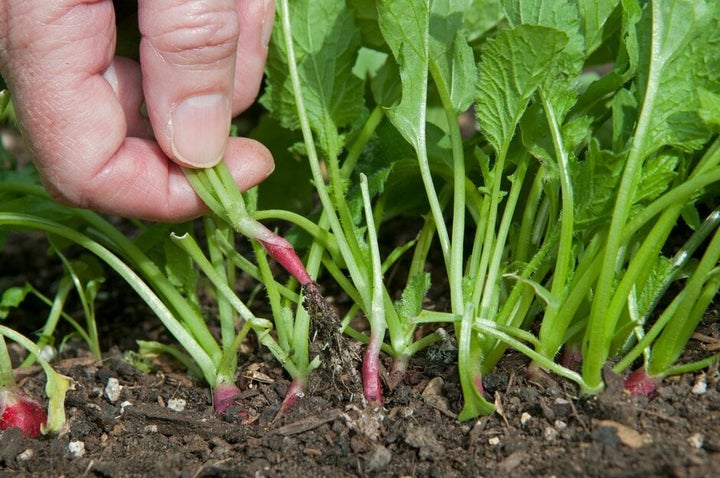
Thinning out seedlings shouldn’t be necessary if you sow salad radishes at least 2.5cm (1in) apart, and larger winter and oriental radishes at least 15cm (5in) apart. However, the seeds are fairly small and can be fiddly to sow thinly, so if your seedlings are too close together, remove the smaller, weaker ones as soon as possible, until you achieve the correct spacing. It may seem a shame to remove perfectly good seedlings, but you should end up with a better crop – the leafy top-growth needs plenty of room, otherwise the root may fail to develop.
Plant Care
Radishes are generally easy to grow, but they do need regular water and warm but not overly hot temperatures, so the roots grow strongly and evenly. Make sure plants aren’t spaced too closely or crowded out by weeds.
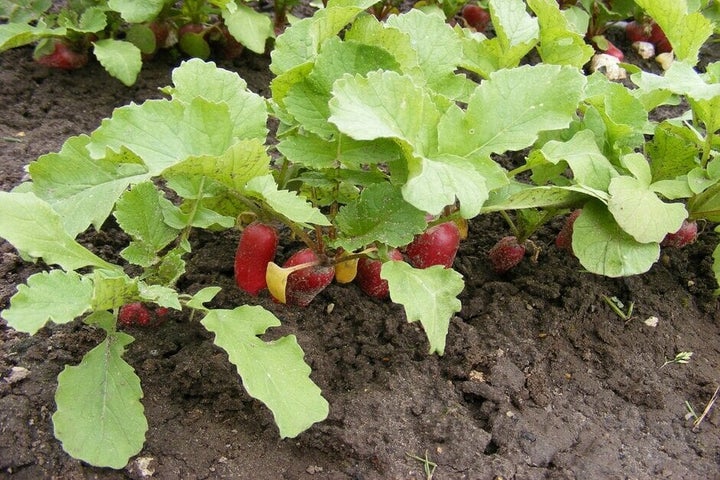
Watering
Keep the soil consistently moist to ensure rapid, even growth and succulent roots that don’t split. This can be tricky in hot, dry summer weather, when watering is required. Roots that go short of water may fail to swell, while inconsistent watering can cause them to split. Plants in containers and young are particularly susceptible to drying out, so take extra care to water regularly.
With salad radishes, spring sowings, when rain is plentiful, are often more successful than summer sowings, when heat and drought may cause poor root development or premature flowering (bolting). For water-saving tips, see below.
Weeding
Weed regularly, so plants don’t have to compete for light and moisture – radishes don't like to be crowded. Hoe between rows but weed by hand close to the radishes, as a hoe could easily damage the roots.
Harvesting
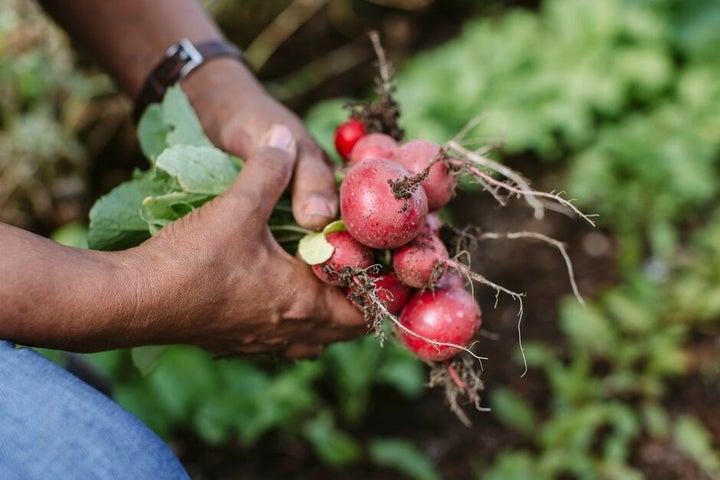
The four main types of radish are harvested at different times and in slightly different ways:
Salad radishes are best harvested young, in as little as four weeks from , when the roots are about 2.5cm (1in) in diameter and mildly peppery. Early sowings take a little longer, ready in six to eight weeks. If left to get too large or old, or to grow slowly, they become pithy, hot and inedible. Pull as required and eat fresh, when crunchy and delicious.
Winter radishes can be left in the ground and dug up as required through winter, or lifted in November and stored in a fridge or similarly cool place. Protect roots left in the ground with cloches, biodegradable fleece or cardboard in freezing weather. Winter radishes stay crisp and don’t turn woody, even when large. The roots can be eaten raw, sliced or grated in salads. The leaves can be eaten too and have a peppery flavour when raw, or can be cooked in a similar way to chard.
Oriental radishes (Japanese, daikon or mooli radishes) usually produce a long white tapered root, for harvesting in late summer and autumn. They are slow growing, taking at least eight weeks to mature, but can reach lengths of 30cm (1ft) or more. They usually have a mild flavour and last well in the ground without turning woody. Eat them raw or cook them in a similar way to winter radishes.

Edible-podded radishes are grown for their immature seed pods and produce a plentiful supply over many weeks, especially in warm weather. Pick the long, pointed pods when young – they’re crisp and peppery, great for adding to salads and stir-fries. If left on the plant too long, the pods turn stringy and inedible, and flowering will stop if the pods aren’t picked regularly. Remove any pods that become over-ripe, to encourage more to form.
Problem Solving
Although radishes are generally trouble free, especially spring sowings, you may get disappointing results if the growing conditions aren’t right. Problems can include:
- Roots fail to swell – this can happen for various reasons, including dry conditions, heat and overcrowding. Salad radishes grow best in mild spring weather – in summer they need regular watering, especially in hot, dry spells. Make sure plants are well spaced – salad radishes at least 2.5cm (1in) apart, winter and oriental radishes 15cm (6in) apart – to give the leafy top-growth room to develop and swell the root.
- Flowering (or ) – this may happen in hot, dry weather, in which case the root won’t develop. Keep plants well watered over the summer and remove any that start to produce a flower stem (unless you want to harvest the edible seed pods).
- Roots are woody, bitter or overly spicy – they are probably too old. Harvest salad radishes as soon as they reach about 2.5cm (1in) in diameter, which should only take about a month (or two months for early sowings) – don’t leave them much longer, as eating quality will suffer.
- Split roots – this is usually caused by uneven moisture levels, so water during dry spells to ensure consistent growth. Split roots are usually still edible.
Radish plants may also be damaged by:
- Slugs and snails – these may eat , especially in damp conditions.
- Cabbage root fly – the larvae tunnel into the roots, especially in late summer. They’re unlikely to trouble fast-growing salad radishes, but may cause problems with slower-growing winter and oriental types that are in the ground for longer – cover crops with biodegradable fleece or insect-proof netting.
- Flea beetles – these eat tiny holes in the leaves, but the damage is usually only cosmetic and doesn’t hinder growth.
For more information on spotting and tackling these issues, see Common problems, below.
Common Problems

Bolting in vegetables
Bolting is the term applied to vegetable crops when they prematurely run to seed, usually making them unusable. A cold spell or changes in day length...

Brassica downy mildew
Downy mildew of brassicas is a foliar disease causing whitish, fuzzy patches on the undersides of leaves and yellow discolouration on the top. It affe...









